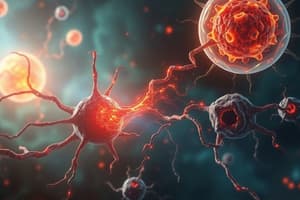Podcast
Questions and Answers
Match the following types of injuries with their descriptions:
Match the following types of injuries with their descriptions:
Chemical mediated injury = Involves binding to critical molecular components Radiation mediated injury = Caused by absorption of radiant energy Oxygen toxicity = Results from excessive reactive oxygen species Cellular aging = Associated with accumulated oxidative damage
Match the following free radicals with their formation processes:
Match the following free radicals with their formation processes:
Superoxide radicals (O2.-) = Generated during reduction-oxidation reactions Hydrogen peroxide (H2O2) = Intermediate product from oxygen reduction Hydroxyl radicals (OH.) = Produced in reactions involving metals Carbon trichloride (CCl3) = Created from metabolic conversion of CCl4
Match the following free radical reactions with their targets:
Match the following free radical reactions with their targets:
Lipid peroxidation = Affects plasma membranes DNA reaction = Involves thymine Protein cross-linking = Denatures and alters protein function Cellular swelling = Leads to vacuolar degeneration
Match the following enzymes with their roles in free radical generation:
Match the following enzymes with their roles in free radical generation:
Match the following consequences of free radical damage:
Match the following consequences of free radical damage:
Match the following types of chemical injury with their mechanisms:
Match the following types of chemical injury with their mechanisms:
Match the following elements with their roles in free radical chemistry:
Match the following elements with their roles in free radical chemistry:
Match the following terms with their related concepts in free radical biology:
Match the following terms with their related concepts in free radical biology:
Match the following types of tumor-associated antigens with their corresponding cancer types:
Match the following types of tumor-associated antigens with their corresponding cancer types:
Match the following TNM staging components with their descriptions:
Match the following TNM staging components with their descriptions:
Match the following components of the immune system with their function:
Match the following components of the immune system with their function:
Match the following terms related to immunity with their categories:
Match the following terms related to immunity with their categories:
Match the following elements of T-lymphocytes with their specific roles:
Match the following elements of T-lymphocytes with their specific roles:
Match the following grades of tumor differentiation with their levels of anaplasia:
Match the following grades of tumor differentiation with their levels of anaplasia:
Match the following characteristics of the immune response with their corresponding types:
Match the following characteristics of the immune response with their corresponding types:
Match the following types of cancer with their associated tumor markers:
Match the following types of cancer with their associated tumor markers:
Match the following conditions with their descriptions:
Match the following conditions with their descriptions:
Match the following causes with the conditions they are associated with:
Match the following causes with the conditions they are associated with:
Match the following pigments with their sources:
Match the following pigments with their sources:
Match the following cellular changes with their visibility under a light microscope:
Match the following cellular changes with their visibility under a light microscope:
Match the following diseases with their characteristic features:
Match the following diseases with their characteristic features:
Match the following conditions with the organs they most commonly affect:
Match the following conditions with the organs they most commonly affect:
Match the following cytological features with their related substances:
Match the following cytological features with their related substances:
Match the following metabolic disturbances with their effects:
Match the following metabolic disturbances with their effects:
Match the following processes with their descriptions:
Match the following processes with their descriptions:
Match the following triggers of apoptosis with their descriptions:
Match the following triggers of apoptosis with their descriptions:
Match the following types of intracellular accumulation with their characteristics:
Match the following types of intracellular accumulation with their characteristics:
Match the following apoptosis features with their descriptions:
Match the following apoptosis features with their descriptions:
Match the following physiological conditions with their apoptotic processes:
Match the following physiological conditions with their apoptotic processes:
Match the following pancreatic conditions with their consequences:
Match the following pancreatic conditions with their consequences:
Match the following apoptosis initiators with their effects:
Match the following apoptosis initiators with their effects:
Match the following terms with their definitions:
Match the following terms with their definitions:
Match the T cell subsets with their primary function:
Match the T cell subsets with their primary function:
Match the immunoglobulin types with their primary characteristics:
Match the immunoglobulin types with their primary characteristics:
Match the cell surface markers with their corresponding cell types:
Match the cell surface markers with their corresponding cell types:
Match the antigen presenting functions with the respective cells:
Match the antigen presenting functions with the respective cells:
Match the processes involved in T cell activation:
Match the processes involved in T cell activation:
Match the cytokines with the T cell subsets they are primarily associated with:
Match the cytokines with the T cell subsets they are primarily associated with:
Match the functions of B-lymphocytes and macrophages:
Match the functions of B-lymphocytes and macrophages:
Match the features of CD4 and CD8 T cells:
Match the features of CD4 and CD8 T cells:
Flashcards are hidden until you start studying
Study Notes
Free Radicals
- Highly reactive chemical species with a single unpaired electron in their outer orbital.
- Readily react with organic and inorganic chemicals.
- Generated within cells through absorption of radiant energy, redox reactions, and enzymatic catabolism of oxygenous chemicals.
- Contribute to chemical injury, radiation injury, oxygen toxicity, cellular aging, microbial killing, and inflammatory damage.
Chemical Injury
- Two main mechanisms: combining with critical molecular components or being converted to reactive toxic metabolites by enzymes like P-450 oxidases.
- Example: Carbon tetrachloride (CCl4) is converted to the toxic free radical CCl3. in the liver, leading to membrane peroxidation and damage to the endoplasmic reticulum.
Patterns of Acute Cell Injury
- Reversible Cell Injury:
- Cell swelling (hydropic changes)
- Fatty change (accumulation of triglycerides)
- Microscopically, it is composed of structureless amorphous granular debris within granulomatous inflammation
- Irreversible Cell Injury:
- Necrosis: characterized by cell death and breakdown.
- Apoptosis: programmed cell death, characterized by nuclear fragmentation and formation of apoptotic bodies.
- Fat Necrosis: focal areas of fat destruction often seen in acute pancreatitis
Apoptosis
- Programmed cell death involved in physiological and pathological conditions.
- Initiated by withdrawal of growth factors, engagement of specific receptors, injury by toxins and free radicals, and intrinsic protease activation.
- Characterized by nuclear condensation and fragmentation, and the formation of apoptotic bodies.
- No inflammatory response is elicited.
Intracellular Accumulations
- Normal cells accumulate abnormal substances, either transiently or permanently.
- Classified into three categories: normal endogenous substance, normal or abnormal endogenous substance that can't be metabolized due to genetic defects, and abnormal exogenous substances.
- Examples: fatty change (steatosis), cholesterol and cholesterol esters, proteins, glycogen, and pigments.
Fatty Change (Steatosis)
- Abnormal accumulation of triglycerides within parenchymal cells.
- Most often seen in the liver, but can occur in the heart, skeletal muscle, kidney, and other organs.
- Caused by toxins, diabetes mellitus, protein malnutrition, obesity, and anoxia.
- May impair cellular function in severe cases.
Cholesterol and Cholesterol Esters
- Macrophages in contact with lipid debris of necrotic cells can become filled with lipid, appearing as foamy cells.
- Atherosclerosis involves smooth muscle cells and macrophages filled with cholesterol and cholesterol esters.
- Xanthomas are accumulations of fat within macrophages of subcutaneous connective tissues.
Pathologic Calcification
- Abnormal accumulation of calcium salts, often with smaller amounts of iron, magnesium, and other minerals.
- Can be found in various conditions including:
- Atherosclerosis
- Tuberculosis
- Damaged heart valves
Tumor-Associated Antigens
- Shared by normal and transformed cells.
- Examples: prostate-specific antigen (PSA), alpha-fetoprotein (AFP), and carcinoembryonic (CEA) antigen.
Grading and Staging
- Grading: based on the cytological differentiation of tumor cells and the number of mitoses.
- Graded I, II, III, or IV in order of increasing anaplasia.
- Staging: based on the size of the primary lesion, extent of spread to regional lymph nodes, and presence or absence of metastases.
- TNM staging system: T (tumor size), N (lymph node metastases), M (distant metastases).
The Immune System
- Innate Immunity: non-specific defense mechanisms present before infection.
- Includes epithelial barriers, phagocytic cells, NK cells, and complement system.
- Adaptive Immunity: specific defense mechanisms that adapt to microbes.
- Includes cell-mediated immunity (T lymphocytes) and humoral immunity (B lymphocytes and antibodies).
Cells of the Immune System
- T lymphocytes: make up 60-70% of circulating lymphocytes.
- Each T-cell has a specific TCR (T cell receptor) composed of alpha and beta polypeptide chains.
- CD4 and CD8 are expressed on different T-cell subsets and act as coreceptors.
- CD4+ T cells bind to Class II MHC molecules and help activate B cells.
- CD8+ T cells bind to Class I MHC molecules and kill cells infected with viruses or cancer cells.
- B lymphocytes: constitute 10-20% of circulating lymphocytes.
- Transform into plasma cells that secrete antibodies after antigen stimulation.
- Express immunoglobulin receptors on their surface (BCR).
- Macrophages: present antigens to T-cells, produce cytokines, and secrete toxic metabolites and proteolytic enzymes.
- Other important cells of the immune system: NK cells (destroy virus-infected cells), neutrophils (phagocytize bacteria)
Activation of T lymphocytes
- Activation requires two signals:
- Engagement of TCR by appropriate MHC-antigen complex with CD4 or CD8 coreceptors.
- Interaction of CD28 on T cells with CD80 or CD86 on antigen-presenting cells.
- Absence of the second signal leads to apoptosis or anergy, preventing autoimmunity.
Studying That Suits You
Use AI to generate personalized quizzes and flashcards to suit your learning preferences.



